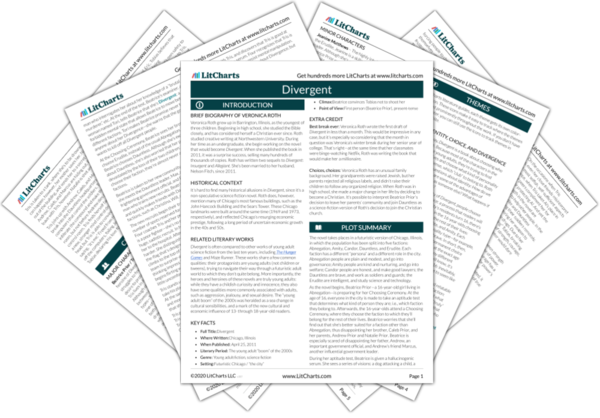Summary
Analysis
The next day, Beatrice and Caleb ride the bus to the Choosing Ceremony. At the Hub, they join their fellow Abnegation members and walk into a large room, which is arranged as a series of concentric circles, decorated to symbolize each of the five factions. Beatrice and Caleb’s parents, who have traveled to the ceremony separately, kiss their children and say, “See you soon.” Beatrice thinks that, in fact, she may never see her parents again.
This is a poignant moment, not least because Beatrice’s parents (at least as far as Beatrice knows) have no idea that their daughter is considering leaving their faction altogether. Because of the structure of the city’s society, switching factions essentially means saying goodbye to one’s family forever—another reminder of the absurdity of making a monumental choice about one’s life at the age of 16.
Themes
The ceremony begins: Marcus stands at a podium and makes a long, formal speech. In his speech, Marcus praises the factions of the city for joining together in peace. As Marcus explains, the five factions were formed to eradicate what each faction saw as the source of evil. The people who believed that selfishness was the source of all evil became Abnegation; those who hated ignorance became Erudite; those who hated dishonesty became Candor; those who hated cowardice became Dauntless; and those who hated aggression became Amity.
It’s telling that each of the five factions is defined negatively—which is to say, defined as a reaction to its own opposite. For instance, the Dauntless faction is designed as a reaction to cowardice first, and as a celebration of bravery second. This suggests that no single faction could survive on its own for long, as each one is defined by its relationship with the four other factions—a delicate balance that threatens to spill over into war at any moment.
Themes
Marcus continues explaining the five factions. Each of the five factions has a special job for maintaining the city. The Dauntless protect the city; the Erudite provide teachers and scientists; Abnegation provides selfless government officials; Candor provides honest, reliable legal workers; and Amity provides kindhearted counselors and caretakers.
The factions aren’t just communities—each faction implies a certain personality type, which every member of that faction is meant to imitate. This whole system once again reads as an absurd and oversimplified view of human nature, suggesting just how “dystopian” and dehumanizing this society is.
Themes
After concluding his speech, Marcus calls each 16-year-old child to the front of the room, one at a time. Marcus gives each teenager a knife, which the teenager uses to cut his or her hand over one of five bowls. By bleeding into the bowl that symbolizes the proper faction, each teenager makes a choice about which faction to belong to.
The choosing ceremony impresses upon its 16-year-olds the seriousness of their choice: the teenagers are literally giving up a part of their selves by committing to one faction. The presence of blood in the ceremony reminds us of the violence and conflict implicit in the division of the city into five factions, and also adds a kind of primal, religious significance to this otherwise futuristic society. Each young person is essentially choosing a “tribe,” and doing so by offering a sacrifice of blood.
Themes
Get the entire Divergent LitChart as a printable PDF.

When it’s Caleb’s turn to cut his hand, he drips blood over the Erudite bowl. There’s a mutter of surprise in the room: Caleb is choosing a new faction for himself instead of remaining in Abnegation, as Beatrice had assumed he’d do.
Caleb sets the standard for the Prior family by “defecting” to another tribe. This suggests that Beatrice isn’t the only one feeling anxiety about her future and her identity—probably, everyone around her is going through the same thing. All this could also be read as a more sinister version of a similar scene (with the Sorting Hat) in the most famous “young adult” series of all—Harry Potter.
Themes
When it’s Beatrice’s turn, she imagines herself joining Abnegation and spending the rest of her life around her friends and family. Since Caleb is leaving Abnegation, she thinks, she has no choice but to remain—leaving now would only break her parents’ hearts. But as she prepares to cut her hand and make her choice, Beatrice thinks, “I am selfish. I am brave.” Instead of dripping blood into Abnegation, she holds her hand over the Dauntless bowl.
The calculations that go through Beatrice’s mind in this scene are familiar to any young adult trying to both “fit in” and “be herself.” Beatrice wants to please her parents, but she also wants to be her own person—to make a choice for her own sake, not her family’s. At the end of the day, Beatrice’s sense of freedom and personal worth wins out—she chooses the “selfish” option (really just the option of freedom and rebelliousness) and leaves Abnegation.
Themes












